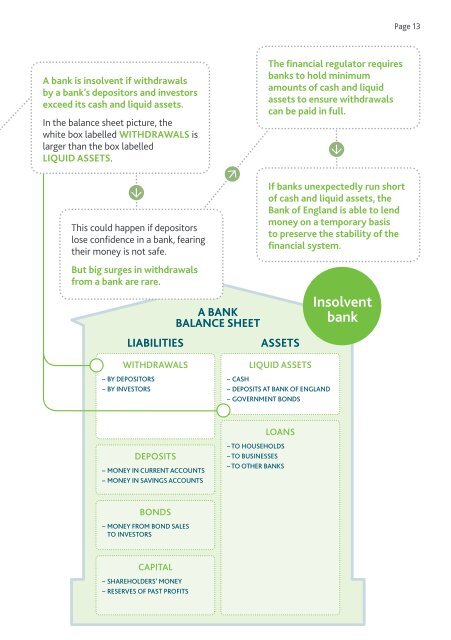xz0n7
xz0n7
xz0n7
Create successful ePaper yourself
Turn your PDF publications into a flip-book with our unique Google optimized e-Paper software.
Page 13<br />
A bank is insolvent if withdrawals<br />
by a bank’s depositors and investors<br />
exceed its cash and liquid assets.<br />
In the balance sheet picture, the<br />
white box labelled WITHDRAWALS is<br />
larger than the box labelled<br />
LIQUID ASSETS.<br />
The financial regulator requires<br />
banks to hold minimum<br />
amounts of cash and liquid<br />
assets to ensure withdrawals<br />
can be paid in full.<br />
This could happen if depositors<br />
lose confidence in a bank, fearing<br />
their money is not safe.<br />
But big surges in withdrawals<br />
from a bank are rare.<br />
A BANK<br />
BALANCE SHEET<br />
LIABILITIES<br />
ASSETS<br />
If banks unexpectedly run short<br />
of cash and liquid assets, the<br />
Bank of England is able to lend<br />
money on a temporary basis<br />
to preserve the stability of the<br />
financial system.<br />
Insolvent<br />
bank<br />
WITHDRAWALS<br />
– BY DEPOSITORS<br />
– BY INVESTORS<br />
LIQUID ASSETS<br />
– CASH<br />
– DEPOSITS AT BANK OF ENGLAND<br />
– GOVERNMENT BONDS<br />
DEPOSITS<br />
– MONEY IN CURRENT ACCOUNTS<br />
– MONEY IN SAVINGS ACCOUNTS<br />
LOANS<br />
– TO HOUSEHOLDS<br />
– TO BUSINESSES<br />
– TO OTHER BANKS<br />
BONDS<br />
– MONEY FROM BOND SALES<br />
TO INVESTORS<br />
CAPITAL<br />
– SHAREHOLDERS’ MONEY<br />
– RESERVES OF PAST PROFITS




